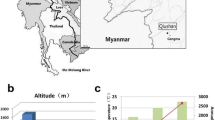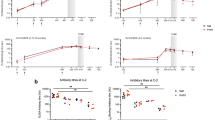Abstract
A malaria vaccine targeting Plasmodium falciparum remains a strategic goal for malaria control. If a polyvalent vaccine is to be developed, its subunits would probably be chosen based on immunogenicity (concentration of elicited antibodies) and associations of selected antigens with protection. We propose an additional possible selection criterion for the inclusion of subunit antigens; that is, coordination between elicited antibodies. For the quantitative estimation of this coordination, we developed a malaria serological map (MSM). Construction of the MSM was based on three categories of variables: (i) malaria antigens, (ii) total IgG and IgG subclasses, (iii) different sources of plasma. To validate the MSM, in this study, we used four malaria antigens (AMA1, MSP2-3D7, MSP2-FC27 and Pf332-C231) and re-grouped the plasma samples into five pairs of subsets based on age, gender, residence, HbAS and malaria morbidity in 9 years. The plasma total IgG and IgG subclasses to the test antigens were measured, and the whole material was used for the MSM construction. Most of the variables in the MSM were previously tested and their associations with malaria morbidity are known. The coordination of response to each antigens pair in the MSM was quantified as the correlation rate (CR = overall number of significant correlations/total number of correlations × 100 %). Unexpectedly, the results showed that low CRs were mostly associated with variables linked with malaria protection and the antigen eliciting the least CRs was the one associated with protection. The MSM is, thus, of potential value for vaccine design and understanding of malaria natural immunity.


Similar content being viewed by others
References
Barnes KI, Chanda P, Ab Barnabas G (2009) Impact of the large-scale deployment of artemether/lumefantrine on the malaria disease burden in Africa: case studies of South Africa, Zambia and Ethiopia. Malar J 8(Suppl 1):S8
World Health Organization (WHO) (2009) World Malaria Report 2009
Ogutu BR, Apollo OJ, McKinney D, Okoth W, Siangla J, Dubovsky F, Tucker K, Waitumbi JN, Diggs C, Wittes J, Malkin E, Leach A, Soisson LA, Milman JB, Otieno L, Holland CA, Polhemus M, Remich SA, Ockenhouse CF, Cohen J, Ballou WR, Martin SK, Angov E, Stewart VA, Lyon JA, Heppner DG, Withers MR; MSP-1 Malaria Vaccine Working Group (2009) Blood stage malaria vaccine eliciting high antigen-specific antibody concentrations confers no protection to young children in Western Kenya. PLoS One 4(3):e4708
Cummings JF, Spring MD, Schwenk RJ, Ockenhouse CF, Kester KE, Polhemus ME, Walsh DS, Yoon IK, Prosperi C, Juompan LY, Lanar DE, Krzych U, Hall BT, Ware LA, Stewart VA, Williams J, Dowler M, Nielsen RK, Hillier CJ, Giersing BK, Dubovsky F, Malkin E, Tucker K, Dubois MC, Cohen JD, Ballou WR, Heppner DG Jr (2010) Recombinant Liver Stage Antigen-1 (LSA-1) formulated with AS01 or AS02 is safe, elicits high titer antibody and induces IFN-gamma/IL-2 CD4+ T cells but does not protect against experimental Plasmodium falciparum infection. Vaccine 28:5135–5144
Thera MA, Doumbo OK, Coulibaly D, Laurens MB, Ouattara A, Kone AK, Guindo AB, Traore K, Traore I, Kouriba B, Diallo DA, Diarra I, Daou M, Dolo A, Tolo Y, Sissoko MS, Niangaly A, Sissoko M, Takala-Harrison S, Lyke KE, Wu Y, Blackwelder WC, Godeaux O, Vekemans J, Dubois MC, Ballou WR, Cohen J, Thompson D, Dube T, Soisson L, Diggs CL, House B, Lanar DE, Dutta S, Heppner DG Jr, Plowe CV (2011) A field trial to assess a blood-stage malaria vaccine. N Engl J Med 365:1004–1013
Olugbile S, Villard V, Bertholet S, Jafarshad A, Kulangara C, Roussilhon C, Frank G, Agak GW, Felger I, Nebie I, Konate K, Kajava AV, Schuck P, Druilhe P, Spertini F, Corradin G (2011) Malaria vaccine candidate: design of a multivalent subunit α-helical coiled coil poly-epitope. Vaccine 29:7090–7099
Trieu A, Kayala MA, Burk C, Molina DM, Freilich DA, Richie TL, Baldi P, Felgner PL, Doolan DL (2011) Sterile protective immunity to malaria is associated with a panel of novel P. falciparum antigens. Mol Cell Proteomics 10:M111.007948
Osier FH, Fegan G, Polley SD, Murungi L, Verra F, Tetteh KK, Lowe B, Mwangi T, Bull PC, Thomas AW, Cavanagh DR, McBride JS, Lanar DE, Mackinnon MJ, Conway DJ, Marsh K (2008) Breadth and magnitude of antibody responses to multiple Plasmodium falciparum merozoite antigens are associated with protection from clinical malaria. Infect Immun 76:2240–2248
Nasr A, Iriemenam NC, Troye-Blomberg M, Arnot D, Theander TG, Berzins K, Giha HA, Elghazali G (2011) Pattern of pre-existing IgG subclass responses to a panel of asexual stage malaria antigens reported during the lengthy dry season in Daraweesh, Sudan. Scand J Immunol 74:390–396
Giha HA, Rosthoj S, Dodoo D, Hviid L, Satti GM, Scheike T, Arnot DE, Theander TG (2000) The epidemiology of febrile malaria episodes in an area of unstable and seasonal transmission. Trans R Soc Trop Med Hyg 94:645–651
Creasey A, Giha H, Hamad AA, El Hassan IM, Theander TG, Arnot DE (2004) Eleven years of malaria surveillance in a Sudanese village highlights unexpected variation in individual disease susceptibility and outbreak severity. Parasitology 129:263–271
Nasr A, Elghazali G, Giha H, Troye-Blomberg M, Berzins K (2008) Interethnic differences in carriage of haemoglobin AS and Fcgamma receptor IIa (CD32) genotypes in children living in eastern Sudan. Acta Trop 105:191–195
Nasr A, Iriemenam NC, Giha HA, Balogun HA, Anders RF, Troye-Blomberg M, ElGhazali G, Berzins K (2009) FcgammaRIIa (CD32) polymorphism and anti-malarial IgG subclass pattern among Fulani and sympatric ethnic groups living in eastern Sudan. Malar J 8:43
Giha HA, Nasr A, Iriemenam NC, Balogun HA, Arnot D, Theander TG, Troye-Blomberg M, Berzins K, ElGhazali G (2010) Age-dependent association between IgG2 and IgG3 subclasses to Pf332-C231 antigen and protection from malaria, and induction of protective antibodies by sub-patent malaria infections, in Daraweesh. Vaccine 28:1732–1739
Perlmann H, Perlmann P, Berzins K, Wåhlin B, Troye-Blomberg M, Hagstedt M, Andersson I, Högh B, Petersen E, Björkman A (1989) Dissection of the human antibody response to the malaria antigen Pf155/RESA into epitope specific components. Immunol Rev 112:115–132
Nasr A, Iriemenam NC, Troye-Blomberg M, Giha HA, Balogun HA, Osman OF, Montgomery SM, ElGhazali G, Berzins K (2007) Fc gamma receptor IIa (CD32) polymorphism and antibody responses to asexual blood-stage antigens of Plasmodium falciparum malaria in Sudanese patients. Scand J Immunol 66:87–96
Crompton PD, Pierce SK, Miller LH (2010) Advances and challenges in malaria vaccine development. J Clin Invest 120:4168–4178
Hill AV (2011) Vaccines against malaria. Philos Trans R Soc Lond B Biol Sci 366:2806–2814
Heppner DG Jr, Kester KE, Ockenhouse CF, Tornieporth N, Ofori O, Lyon JA, Stewart VA, Dubois P, Lanar DE, Krzych U, Moris P, Angov E, Cummings JF, Leach A, Hall BT, Dutta S, Schwenk R, Hillier C, Barbosa A, Ware LA, Nair L, Darko CA, Withers MR, Ogutu B, Polhemus ME, Fukuda M, Pichyangkul S, Gettyacamin M, Diggs C, Soisson L, Milman J, Dubois MC, Garçon N, Tucker K, Wittes J, Plowe CV, Thera MA, Duombo OK, Pau MG, Goudsmit J, Ballou WR, Cohen J (2005) Towards an RTS,S-based, multi-stage, multi-antigen vaccine against falciparum malaria: progress at the Walter Reed Army Institute of Research. Vaccine 23:2243–2250
Arnot DE, Cavanagh DR, Remarque EJ, Creasey AM, Sowa MP, Morgan WD, Holder AA, Longacre S, Thomas AW (2008) Comparative testing of six antigen-based malaria vaccine candidates directed toward merozoite-stage Plasmodium falciparum. Clin Vaccine Immunol 15:1345–1355
Garraud O, Perraut R, Diouf A, Nambei WS, Tall A, Spiegel A, Longacre S, Kaslow DC, Jouin H, Mattei D, Engler GM, Nutman TB, Riley EM, Mercereau-Puijalon O (2002) Regulation of antigen-specific immunoglobulin G subclasses in response to conserved and polymorphic Plasmodium falciparum antigens in an in vitro model. Infect Immun 70:2820–2827
Tongren JE, Drakeley CJ, McDonald SL, Reyburn HG, Manjurano A, Nkya WM, Lemnge MM, Gowda CD, Todd JE, Corran PH, Riley EM (2006) Target antigen, age, and duration of antigen exposure independently regulate immunoglobulin G subclass switching in malaria. Infect Immun 74:257–264
Aucan C, Traoré Y, Tall F, Nacro B, Traoré-Leroux T, Fumoux F, Rihet P (2000) High immunoglobulin G2 (IgG2) and low IgG4 levels are associated with human resistance to Plasmodium falciparum malaria. Infect Immun 68:1252–1258
Roussilhon C, Oeuvray C, Müller-Graf C, Tall A, Rogier C, Trape JF, Theisen M, Balde A, Pérignon JL, Druilhe P (2007) Long-term clinical protection from falciparum malaria is strongly associated with IgG3 antibodies to merozoite surface protein 3. PLoS Med 4(11):e320
Baird JK (1995) Host age as a determinant of naturally acquired immunity to Plasmodium falciparum. Parasitol Today 11:105–111
Acknowledgement
We are thankful to the donors from Daraweesh and Kajara villages in Eastern Sudan. The Daraweesh Project was built on several short- and long-term projects which received funds from several bodies, principally, DANIDA and TDR/WHO from 1990 to 2004. Riad Bayoumi, Thor Theander, Lars Hviid and David Arnot were the principal founders of the project. The current study was supported by grants to M.T.-B. and K.B. from the Swedish Agency for Research Development with Developing Countries/Sida/SAREC), the Swedish Medical Research Council and grants within the BioMalPar European Network of Excellence (LSMP-CT-2004-503578). Professor Robin Anders, La Trobe University, Australia, is acknowledged for the kind supply of the MSP2-3D7 and MSP2-FC27 antigens and AMA-1 recombinant antigens. Ms. Halima Balogun, Stockholm University, Sweden, is acknowledged for the kind supply of the recombinant Pf332-C231 antigen.
Conflict of interest
The authors declare that they have no conflict of interest.
Author information
Authors and Affiliations
Corresponding author
Rights and permissions
About this article
Cite this article
Giha, H.A., Nasr, A.A., Iriemenam, N.C. et al. A malaria serological map indicating the intersection between parasite antigenic diversity and host antibody repertoires. Eur J Clin Microbiol Infect Dis 31, 3117–3125 (2012). https://doi.org/10.1007/s10096-012-1673-z
Received:
Accepted:
Published:
Issue Date:
DOI: https://doi.org/10.1007/s10096-012-1673-z




